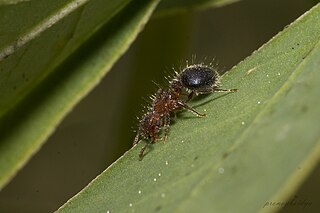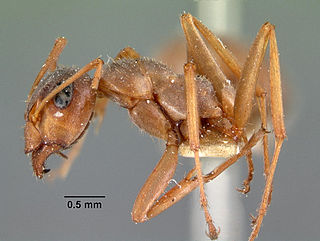
Formica is a genus of ants of the family Formicidae, commonly known as wood ants, mound ants, thatching ants, and field ants. Formica is the type genus of the Formicidae, and of the subfamily Formicinae. The type species of genus Formica is the European red wood ant Formica rufa. Ants of this genus tend to be between 4 and 8 mm long.

Dolichoderinae is a subfamily of ants, which includes species such as the Argentine ant, the erratic ant, the odorous house ant, and the cone ant. The subfamily presents a great diversity of species throughout the world, distributed in different biogeographic realms, from the Palearctic, Nearctic, Afrotropical region and Malaysia, to the Middle East, Australian, and Neotropical regions.
Fulvous is a colour, sometimes described as dull orange, brownish-yellow or tawny; it can also be likened to a variation of buff, beige or butterscotch. As an adjective it is used in the names of many species of birds, and occasionally other animals, to describe their appearance. It is also used as in mycology to describe fungi with greater colour specificity, specifically the pigmentation of the surface cuticle, the broken flesh and the spores en masse.

Technomyrmex albipes, commonly known as the white-footed ant, is a species of ant first described in 1861 from Sulawesi, Indonesia by the British entomologist Frederick Smith. Invasive pest ants in Florida, previously identified as T. albipes, have now been separated as Technomyrmex difficilis, both forming part of a species complex with a worldwide distribution.

Technomyrmex gorgona is a species of ant in the genus Technomyrmex.

Dactylotum bicolor, also known as the rainbow grasshopper, painted grasshopper, or the barber pole grasshopper, is a species of grasshopper in the family Acrididae. It is native to the United States, Canada and northern Mexico and exhibits aposematism. It was first described by the German entomologist Toussaint de Charpentier in 1843.

Technomyrmex is a genus of ants in the subfamily Dolichoderinae. With 98 species, it is one of the largest and most diverse ant genera in the Dolichoderinae. The genus distributed throughout the tropical and subtropical zones with most species occurring in the Oriental-Malesian and Afrotropical regions. One species, Technomyrmex albipes is a tramp ant now widespread throughout the tropics due to human activities.

Ant eggs refer to both the eggs and pupae of weaver ants eaten in several countries across Southeast Asia, especially Laos and Northeastern Thailand (Isan). They are high in protein and enjoyed for their sourness and pop when eaten along with soups, omelets, and salads.

Tapinomini is a tribe of Dolichoderinae ants with 6 genera and one extinct genus.
Technomyrmex elatior is a species of dolichoderine ant which is a widespread species that can be found in many Indo-Australian, Oriental, and Palaearctic regions.
Technomyrmex horni is a species of Dolichoderine ant which is a widespread species that can be found in many Indo-Australian, Oriental, and Palaearctic regions.

Meranoplus bicolor, is a species of ant of the subfamily Myrmicinae. It is found in many Asian countries, where its habitats range from open grasslands to open-canopy forests. They nest in soil, usually at the base of plants. The nest opening is a simple hole, but it can sometimes have multiple openings. Workers forage on the ground as well as on plants, where they exploit extrafloral nectaries and tend to aphids.
Myrmica obscurata is a species of ant of the genus Myrmica. It is found in Sri Lanka.

Formica montana is an ant in the genus Formica in the family Formicidae. A common name for F. montana is "prairie mound ant".

Technomyrmex difficilis, known generally as the white-footed ant or difficult techno ant, is a species of odorous ant in the family Formicidae.

Pogonomyrmex bicolor, the bicolored harvester ant, is a species of ant in the family Formicidae.
The black-and-white langur is a species of monkey in the family Cercopithecidae. It was formerly considered a subspecies of the Black-crested Sumatran langur, Presbytis melalophos but genetic analysis revealed that these are separate species.










